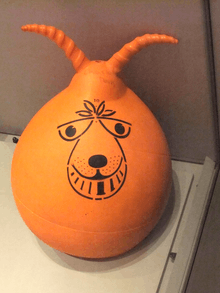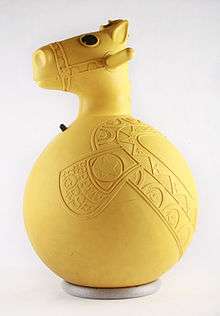Space hopper
A space hopper (also known as a moon hopper, skippyball, kangaroo ball, bouncer, hippity hop, hoppity hop, sit and bounce, or hop ball) is a rubber ball (similar to an exercise ball) with handles which allow one to sit on it without falling off. The user can hop around on the toy, using the elastic properties of the ball to move forward.

The term "space hopper" is more common in the United Kingdom; the toy is less familiar in the United States, and may be known as a "hoppity hop", "hippity hop" or a "sit n bounce". A similar toy popular in the United States in the 1980s was the pogo ball, which has a hard plastic ring encircling the ball instead of a handle.
Use
The space hopper is a heavy rubber balloon about 60–70 centimetres (24–28 in) in diameter, with two rubber handles protruding from the top. A valve at the top allows the balloon to be inflated by a bicycle pump or car tire pump.
A child can sit on top, holding the two handles, and bounce up and down until the balloon leaves the ground. By leaning, the driver can make the balloon bounce in a particular direction. In practical terms, this is a very inefficient form of locomotion, but its simplicity, ease of use, low cost and cheerful appearance appeal to children.
History

The space hopper was invented by Aquilino Cosani of Ledragomma, an Italian company that manufactured toy rubber balls. He patented the idea in Italy in 1968, and in the United States in 1971. Cosani called the toy "Pon-Pon".
Space hoppers were introduced to the United Kingdom in 1969. The Cambridge Evening News newspaper, England, contained an advertisement for the hopper in November of that year[1] and described it as a trend. The space hopper became a major craze for several years, and remained widely popular through the 1980s. They are sometimes considered a symbol of the 1970s.
The original space hopper of the United Kingdom was manufactured by Mettoy (Mettoy-Corgi). Wembley made a similar model which had smooth handles rather than the ribbed original. The orange kangaroo design is now available in adult sized versions in the United Kingdom.
In the United States, the first mass-marketed hopping ball (a version of an earlier European toy) was the Hoppity Hop, released by the Sun company around 1968. Because of the market and media saturation by this toy, any such ball regardless of origin, is now generally known in the United States by that name (or sometimes "hippity hop" as it was originally called in the United States).
The earliest Hoppity Hops were made of rubber (usually red or blue) with a round ring handle on top and automotive tire valve for inflation. In the 1970s Sun introduced various character versions of the Hoppity Hop, such as the Hoppity Horse, Disney's Mickey Mouse and Donald Duck (with hard plastic versions of the character's head attached to the ball).
The Hoppity Hop sold rather steadily for decades, but by the 1990s sales apparently started to slip due to increased competition from foreign hoppers. At some point, the Hoppity Hop came to be made of a vinyl like material, some molded in fluorescent colors. The Hoppity Hop now appears to have been discontinued, but the original – sometimes still in the box – comes up from time to time on online auction sites.
According to advertising materials, the Hoppity Hop's original targets were both adults and children. Since the balls only inflated to around 20 inches (51 cm), however, it is doubtful that any but the shortest adults could have gotten much use out of one. Today, numerous versions can be found in most stores, ranging anywhere from 16–24 inches (41–61 cm). Many are manufactured in China.
The European "Hop!" balls appeared in the beginning of the 1990s and are still available. Made by Italy's Ledragomma/Ledraplastic, these are essentially the quality exercise ball with a handle attached. The sizes of these balls range from the "Hop! 45" to the "Hop! 66" (66 cm, about 26 in).
While it is still used for fun and exercise by many adults, the Hop! 66 is still borderline child sized. The demand for truly adult proportioned hopping balls was met with two notable items. The first of these was Kitt 2000 Velp, of the Netherlands Mega Skippyballs, a large hopping ball which by virtue of its size was intended only for adult use. There were three sizes: 120 centimetres (47 in), 100 centimetres (39 in) and 80 centimetres (31 in).
The Mega Skippyballs are made of extra-strong vinyl, and in the Netherlands there are various Skippyball races and Skippyball championships.
Popular culture
The British animated sketch show Monkey Dust features the recurring character Ivan 'The Meat-Safe Murderer' Dobsky, a man imprisoned in 1974 for a crime he didn't commit, being finally released in every episode with no possessions other than a variety of 1970s clothing and a space hopper called Mr. Hoppy. Mr. Hoppy is eventually revealed to be both sentient and responsible for the Meat-Safe Murders himself (as well as the murder of Dobsky's wife of several hours).
The humorous science fiction novel and audio book Kangazang features space hoppers (referred to as 'Hoppas') who are depicted as an alien race living on the planet Profania Alpha. The space hopper character of Pon-Pon is instrumental in helping the two main characters save the universe.
Space hoppers can be seen being used in the background of one scene in Episode 59 of Star Trek: The Original Series, "And the Children Shall Lead". Episode 12, season 2 (production number 19) of the popular British comedy from the 1970s The Goodies was mostly related to space hoppers. The plot of the episode (called "Charity Bounce") involved a charity bounce on space hoppers from London to Brighton.
The space hopper lent its name and face to the Birmingham psychedelic trance parties that ran from the mid 1990s to 2000, and also appeared at the Glastonbury festival. In a Season 7 episode of Friends, "The One Where They All Turn Thirty", Phoebe bounced for one mile on a Hippity Hop, this being on a list she had made of things to do before turning 30.
In Doctor Who Series 3, Episode 11 "Utopia", the Tenth Doctor refers to Captain Jack's Vortex Manipulator as a space hopper in contrast to his TARDIS, which he calls a sports car. The pornographic parody film Bat Pussy (1973) features the titular character using a space hopper for transportation. A character named Space Hopper, which resembles a toy space hopper, appears in Ian Stewart's book Flatterland.
In The Comic Strip Presents post-apocalyptic / cyberpunk episode Slags (1984), the horns and part of a cut-up space hopper is used as a hood by one of the characters.
In the British crime drama "Endeavour_(TV_series)", episode "Apollo" (2019), a child is seen bouncing on a Space Hopper in a scene contemporaneous with the 1969 Apollo mission, consistent with the toy's 1968/1969 release in the U.K.
In 2018 the British eccentric Steven Payne completed the first crossing of the Alps by spacehopper from Bardoneccia in Italy to Grenoble in France, a journey of 122km which took 19 days.
References
- "1968 And 1969: The Space Hopper In Britain..." September 2, 2006. Retrieved October 19, 2012.
External links
| Wikimedia Commons has media related to Space hoppers. |
- The Space Hopper Forums
- History
- "If you hadn't one, you were hopping mad" – article on the toy